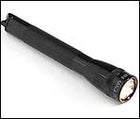This is why all outdoor stores need their very own darkrooms along with those nubby climbing walls and fake rocky inclines. A pitch-black place to compare flashlights. As you point out, what used to be pretty simple is now far too complex. Or seemingly so. The all-knowing Gear Guy can simplify this Babel-like profusion of flashlights and headlamps.
 Mini Maglite
Mini Maglite
First, the light itself. You can pretty much divide lights into two categoriesLED, and everything else. Don’t get too hung up on the xenon, krypton distinctions. Those are all high-output incandescent (heat-generating) bulbs that have a tungsten filament and use a gas inside the bulb (the krypton or xenon) that helps prolong filament life. These lights generally are best when you need the maximum amount of brightnessroute-finding at night, for instance. They’re very powerful, but the downside is that they consume battery juice at a pretty brisk clipfigure four or five hours of burn time with a typical battery load of four AAs. As for the material used to make the flashlight, aluminum is of course extremely rugged. But plastic is lighter, and still very tough. A classic compact flashlight is the Mini Maglite ($10; www.maglite.com), which uses two AA batteries. I must have four or five of those scattered around the house. In a headlamp, Petzl’s Zoom ($32; www.petzl.com) is a classic, and a 4.5-volt battery gives you nearly 20 hours of battery life (downsideeach battery costs more than $6, although you can get an AA adapter).
Light-emitting-diode-equipped lights are fast taking over the flashlight world. LEDs are sort of like tiny lightbulbs, but they don’t have a filament that heats up (and can burn out). Instead, they generate light simply by moving electrons around. Their big plusses are compact size and amazing battery lifeoften 30 to 40-plus hours with one set of AAs. On the downside, they still aren’t quite as bright as incandescent bulbs, so tend to be better for around-camp tasks such as cooking or reading. Gerber’s LX 3.0 LED Flashlight ($50; www.gerberblades.com) is a good example. In the headlamp style, Princeton Tec’s EOS ($39; www.princetontec.com) is very representative.
Nowadays, a lot of headlamps are hybrids, with both LED and incandescent bulbs, so you get the power of an incandescent with the long battery life of an LED, depending on the task at hand. Black Diamond’s Helion headlamp ($45; www.bdel.com) sports a xenon incandescent bulb and three LEDs for one seriously excellent all-around light.
As for watts, lumens, and so onmore is always brighter (not always better, as brighter also means more battery consumption). Just try to compare apples to apples.
Check out the for an expert view of the Princeton Tec EOS.


